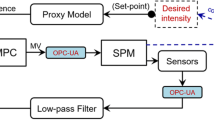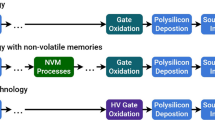Abstract
In practical peening operation, the values of inlet air pressure and media flow rate are manually preset to acquire desired intensity requirements. The operator often needs to perform intensive experimental trials to determine a set of operational inputs for actual production. Obtaining these operational parameters is often time-consuming and labor-intensive. Thus, in this study, we propose an optimal distributed model predictive control for the multiple input/multiple output system to address the issues. In the newly developed system, control actions of inlet air pressure and voltage are optimally obtained with the anticipation of the predictive future states of the plant models, while reference values of air pressure at the nozzle and media flowrate are determined using a proxy model. The dynamical plant models include an air pressure model and a media flowrate model, which are developed based on measurement data and physics-based knowledge using the sparse identification of nonlinear dynamics algorithm. The proxy model is developed from the measurement data of the intensity, pressure, and media flowrate using a deep machine-learning algorithm. The control performance is demonstrated using on-site controls at the physical machine for different operational scenarios. The obtained measurement results exhibit a favorable control performance in stability, robustness, and accuracy. The measurement intensity is consistent with the target setting value; the difference is smaller than the industrial threshold of ± 0.01mmA for all random tests. In another word, all target setting intensity can be achieved without the need of performing trials to determine the operational parameters. It also suggests that the developed control system can be deployed to the physical machine for actual production.















Similar content being viewed by others
Availability of data and material (data transparency)
The authors will make availability of any related data to this manuscript if requested (or data will available on request).
References
Qutaba S, Asmelash M, Saptaji K, Azhari A (2022) A review on peening processes and its effect on surfaces. Int J Adv Manuf Technol 120:4233–4270. https://doi.org/10.1007/s00170-022-09021-6
Kirk D (1999) Shot peening. J Aircr Eng Aerosp Technol 77: 349–361. MCB University Press. ISSN 0002–2667
Burrell NK (1985) Controlled shot peening of automotive components. SAE Trans 94:44–51. www.jstor.org/stable/44721548
Baiker S (2006) Shot peening: a dynamic application and its future. Metal Finishing News. https://books.google.com.sg/books?id=zgVZnQAACAAJ
Marsh KJ (1993) Shot peening: techniques and applications. Engineering Materials Advisory Services Ltd., London
Kirk D (2016) Peening intensity: true meaning and measurement strategy. The Shot Peener 3:(3). https://www.shotpeener.com/library/pdf/2016030.pdf
Champaigne J (1992) Shot peening intensity measurement. The Shot Peener 6(4):1–6. https://www.shotpeener.com/library/pdf/1992082.pdf
Franck Petit-Renaud (2018) Optimization of the shot peening parameters. The Shot Peener. https://www.shotpeener.com/library/pdf/2002018.pdf
Miao HY, Larose S, Perron C, Lévesque M (2010) An analytical approach to relate shot peening parameters to Almen intensity. Surf Coat Technol 205(7):2055–2066. https://doi.org/10.1016/j.surfcoat.2010.08.105
Nasir V, Sassani F (2021) A review on deep learning in machining and tool monitoring: methods, opportunities, and challenges. Int J Adv Manuf Technol 115:2683–2709. https://doi.org/10.1007/s00170-021-07325-7
Weichert D, Link P, Stoll A, Rüping S, Ihlenfeldt S, Wrobel S (2019) A review of machine learning for the optimization of production processes. Int J Adv Manuf Technol 104:1889–1902. https://doi.org/10.1007/s00170-019-03988-5
Rom M, Brockmann M, Herty M, Iacomini E (2022) Machine learning tools in production engineering. Int J Adv Manuf Technol. https://doi.org/10.1007/s00170-022-09591-5
Žapčević S, Butala P (2013) Adaptive process control based on a self-learning mechanism in autonomous manufacturing systems. Int J Adv Manuf Technol 66:1725–1743. https://doi.org/10.1007/s00170-012-4453-0
Nguyen VB, Teo A, Ba T, Aramcharoen A, Ahluwalia K, Tran SBQ, Kang CW (2021) Advanced model-based controller for cyber-physical shot peening process. Int J Adv Manuf Technol 114:2929–2943. https://doi.org/10.1007/s00170-021-07009-2
Nguyen VB, Ba T, Teo A, Aramcharoen A, Ahluwalia K, Kang CW (2022) A PID model based controller for automated shot peening processes. In: Wei, Y., Chng, S. (eds) Proceedings of the 2nd International Conference on Advanced Surface Enhancement (INCASE 2021). INCASE 2021. Lecture Notes in Mechanical Engineering. Springer, Singapore. https://doi.org/10.1007/978-981-16-5763-4_47
Teo A, Ahluwalia K, Aramcharoen A (2020) Experimental investigation of shot peening: correlation of pressure and shot velocity to Almen intensity. Int J Adv Manuf Technol 106:4859–4868. https://doi.org/10.1007/s00170-020-04982-y
Nguyen VB, Te B, Teo A, Ahluwalia K, Aramcharoen A, Kang CW (2022) A blended empirical shot stream velocity model for improvement of shot peening production. Int J Adv Manuf Technol 118:801–815. https://doi.org/10.1007/s00170-021-07972-w
Chen T, Carlos G (2016) XGBoost: a scalable tree boosting system. Proceedings of the 22nd ACM SIGKDD. International Conference on Knowledge Discovery and Data Mining - KDD 16. ACM Press. https://doi.org/10.1145/2939672.2939785.
Christofides PD, Scattolini R, Muñoz de la Peña D, Liu J (2013) Distributed model predictive control: a tutorial review and future research directions. Comput Chem Eng 51:21–41. https://doi.org/10.1016/j.compchemeng.2012.05.011
Brunton SL, Proctor JL, Kutz JN (2016) Sparse identification of nonlinear dynamics with control (SINDYc). IFAC-Papers Online 49(18): 710–715. https://doi.org/10.1016/j.ifacol.2016.10.249
Kaiser E, Kutz JN, Brunton SL (2018) Sparse identification of nonlinear dynamics for model predictive control in the low-data limit. Proc Math Phys Eng Sci 474(2219):20180335. https://doi.org/10.1098/rspa.2018.0335
Nguyen VB, Poh HJ, Zhang YW (2014) Predicting shot peening coverage using multi-phase computational fluid dynamics simulations. J Powder Technol 256:100–112. https://doi.org/10.1016/j.powtec.2014.01.097
Funding
This work is supported by the project entitled “Machine Learning Assisted Control of Shot Peening Process” under grant number A1894a0032 at Institute of High Performance Computing (IHPC) and Advanced Remanufacturing and Technology Centre (ARTC), A*STAR, Singapore.
Author information
Authors and Affiliations
Contributions
Van Bo Nguyen: developed the framework for obtaining process models and proxy model, analyzed data and develop the process models and proxy model, and the control system using distributed MPC, refined both process models and controller, performed all control scenarios for validation and demonstration, developed ideas for this paper, analyzed data, wrote original, and revised paper. Augustine Teo: design experiments, performed experimental trials, analyzed data, and revised paper. Te Ba: discussed, analyzed data, and revised paper. Kunal Ahluwalia: provided some idea on experimental setup and revised paper. Chang Wei Kang: managed and provided direction for research development, provided ideas on control design, and revised paper.
Corresponding author
Ethics declarations
We confirm that this paper is original and has not been published elsewhere nor is it currently under consideration for publication elsewhere.
Ethics approval
Not applicable.
Consent to participate
Not applicable.
Consent for publication
Not applicable.
Conflict of interest
The authors declare no competing interests.
Additional information
Publisher's Note
Springer Nature remains neutral with regard to jurisdictional claims in published maps and institutional affiliations.
Rights and permissions
Springer Nature or its licensor holds exclusive rights to this article under a publishing agreement with the author(s) or other rightsholder(s); author self-archiving of the accepted manuscript version of this article is solely governed by the terms of such publishing agreement and applicable law.
About this article
Cite this article
Nguyen, V.B., Teo, A., Ba, T. et al. A distributed model predictive control with machine learning for automated shot peening machine in remanufacturing processes. Int J Adv Manuf Technol 122, 2419–2431 (2022). https://doi.org/10.1007/s00170-022-10018-4
Received:
Accepted:
Published:
Issue Date:
DOI: https://doi.org/10.1007/s00170-022-10018-4




